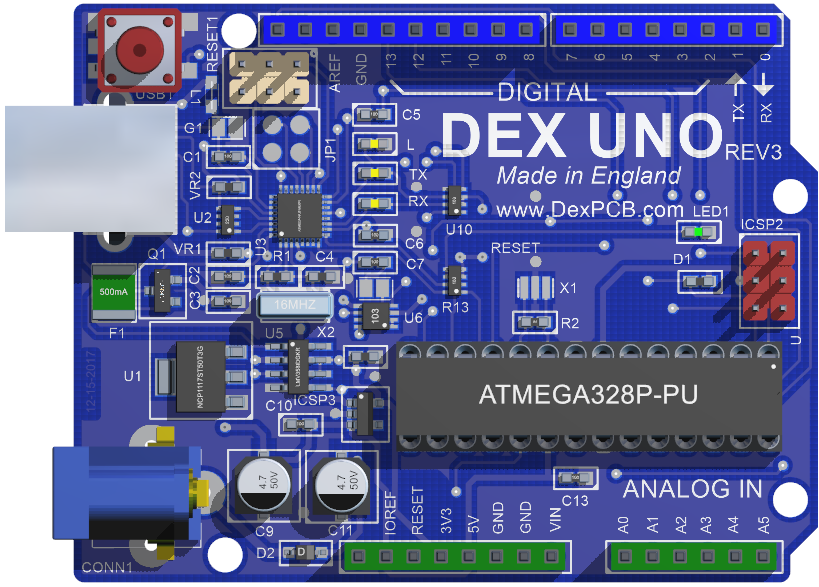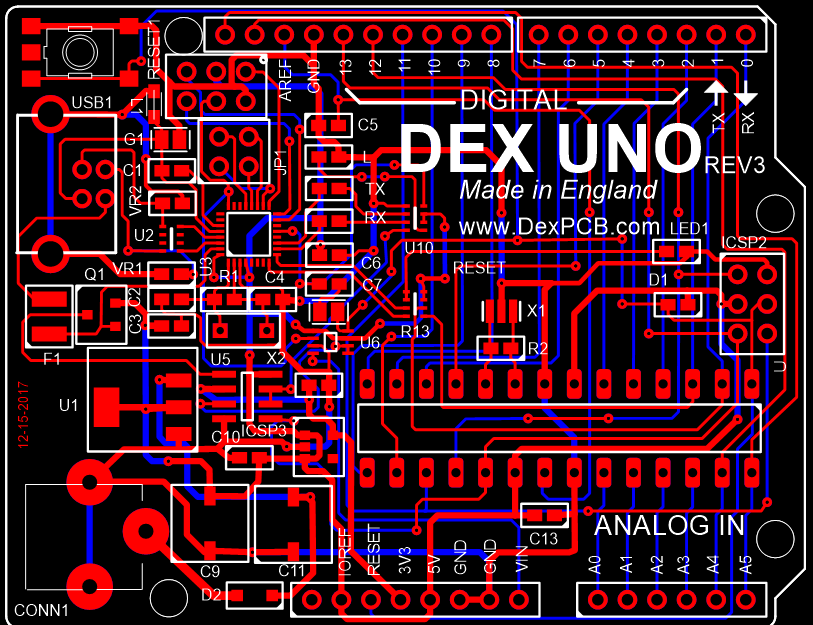Click Help→Samples→  to open AutoTRAX DEX UNO sample project.
to open AutoTRAX DEX UNO sample project.
AutoTRAX DEX Uno is a micro-controller board based on the ATmega328P. It has 14 digital input/output pins (of which 6 can be used as PWM outputs), 6 analog inputs, a 16 MHz quartz crystal, a USB connection, a power jack, an ICSP header and a reset button. It contains everything needed to support the micro-controller; simply connect it to a computer with a USB cable or power it with a AC-to-DC adapter or battery to get started.
You are free to modify and use; however, you must comply with the Arduino license.

The DEX DEX UNO Sample Project

Orthographic 3D View from the Top

The Schematic

The PCB
Arduino
Arduino is an open-source electronics platform that uses easy-to-use hardware and software. The hardware consists of a physical programmable circuit board (often referred to as a micro-controller), and the software is a piece of software, or Integrated Development Environment (IDE), that runs on your computer and is used to write and upload computer code to the physical board.
The Arduino platform has become quite popular with people just starting out with electronics and for good reason. Unlike most previous programmable circuit boards, the Arduino does not need an extra piece of hardware (called a programmer) in order to load a new code onto the board. You can simply use a USB cable. Additionally, the Arduino IDE uses a simplified version of C++, making it easier to learn to program.
The Arduino project started in 2005 as a project for students at the Interaction Design Institute Ivrea in Ivrea, Italy. It was aimed at providing a low-cost and easy way for novices and professionals to create devices that interact with their environment using sensors and actuators.
Since then, Arduino has been widely adopted in a variety of fields, including hobby electronics, education, and industrial applications. It has a large community and a wide array of supplementary add-on "libraries" that enable users to extend the base functionality. It also supports various types of boards beyond the initial Arduino UNO, like the Mega, Nano, Mini, and boards with WiFi and BLE capabilities like the MKR WiFi 1010.
The philosophy of Arduino has always been to make hardware and software accessible to artists, designers, hobbyists, and anyone interested in creating interactive objects or environments. This focus on ease of use makes it an excellent choice for people new to programming and electronics.
Arduino UNO
The Arduino Uno is one of the most popular Arduino boards. It is often the first board many people use when they are learning about Arduino or beginning to experiment with electronics.
Here are some of the key features of the Arduino Uno:
•Micro-controller: It is based on the ATmega328P micro-controller.
•Digital I/O Pins: It has 14 digital input/output pins. Six of these pins can be used as Pulse Width Modulation (PWM) outputs.
•Analog Input Pins: It has 6 analog inputs.
•Operating Voltage: It operates at 5 volts.
•Input Voltage: Recommended range is 7 to 12 volts, but limits are 6-20 volts.
•Flash Memory: 32 KB of which 0.5 KB is used by the bootloader.
•SRAM: 2 KB.
•EEPROM: 1 KB.
•Clock Speed: 16 MHz.
The Arduino Uno is unique in that it includes a built-in USB interface, which allows it to be easily connected to a computer for programming. The board can be powered either from the USB connection or with an external power supply.
Arduino Uno has a wide variety of applications. It can be used to control LEDs, read data from a variety of sensors, control motors, and much more. The ease with which the Arduino can be used to interact with a wide range of hardware makes it a valuable tool for anyone interested in electronics or physical computing.